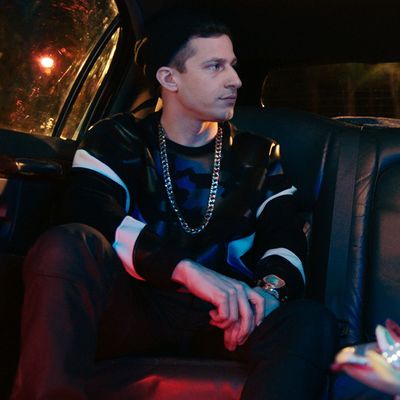
A little over eight years ago, Jason Segel showed his penis for a fleeting moment in Forgetting Sarah Marshall and set the bar for going-for-it male nudity. This past weekend, with the release of Popstar, the Lonely Island’s Akiva Schaffer, Andy Samberg, and Jorma Taccone high-jumped well over that bar. (Spoiler alert from here on forward.)
In the movie Samberg plays Conner, the titular pop star, who made a name for himself after breaking up the band he got his start in, called the Style Boyz. Taccone plays Owen, the former Style Boy who continues to work with Conner as his DJ. Schaffer plays the third Style Boy, Lawrence, who hates Conner for not giving him credit for writing his breakout verse.
In the dick-reveal scene, Owen, Lawrence, and Conner end up confronting each other inside a limousine. As it unfolds, Connor points to a set of exposed breasts in the window behind him as an example of the relationship he has with fans, and indicates his intent to sign them. But, unbeknownst to Conner, while he was making his grand declarations the boobs were replaced by a flaccid penis, which he still proceeds to inscribe. Unlike in Forgetting Sarah Marshall, that junk isn’t just glimpsed; it’s the star of the scene, continuously cut to over and over, and eventually it gets caught in the car window.
Beyond outrageous and unforgettable — as I noted in my essay on the Lonely Island last week — it felt like the culmination of their years of dick jokes. So, when I spoke with the guys earlier this month, it was all I wanted to talk about. Here is the story of how the Lonely Island put a dick in the box that is the movie frame.
I heard in an interview you did, Andy, that the penis limo scene was a reshoot. What was originally there?
Akiva Schaffer: When we were writing the movie, we thought it would be more satisfying story-wise if we kept our characters apart basically for the whole movie. That scene in the hallway, where Conner calls out Owen on the Parent Trap thing, had a whole second half where he basically says, “Get fucking rid of him. I don’t want to see him. I’ll be at the hotel, bye.” And then there was a scene of my character and Owen in a bar basically with him trying to be like, “Hey, let’s get a drink.”
Andy Samberg: Trying to spin it like it’s all good.
Schaffer: And me being like, “Where is he?” And him being like, “Oh, he’s just sick.” And me being like, “I’m not fucking falling for it,” and I kind of lecture him about why Conner’s manipulating him and that he should stand up for himself, too. I put ideas in his head about standing up for himself.
Which would’ve set up how Owen eventually left Conner?
Schaffer: That was the only part of it that we end up missing. The scene was actually totally fine; it wasn’t like, “Oh, we really have something broken here.” No one saw the movie and pinpointed that as the problem. But Judd was always like, “I think we’re just missing an opportunity here. That’s the story everyone’s watching for, the three of you guys together.” And he zeroed in on that scene. We did a ton of different edits and finally got two really good versions of it. But that’s when Judd knew for sure.
Samberg: He was like, “Those are good, and it’s not enough.”
Jorma Taccone: That’s what solidified it.
Schaffer: For us it was always a matter of keeping the tension. The logic was if they’re always apart and you don’t get to see them together, then at the farm when they’re finally face to face it will feel heightened. But it became like, “Why not just shoot something?” And at that point from a comedic level we had actually already shown the movie at previews and heard where audiences were laughing and were—
Samberg: Pleased to learn.
Schaffer: Yeah, pleased to learn that they were laughing at the crazier stuff. Like, you never know if we’re going to lose them at the big setpieces and the big weird stuff like the bin Laden song. And No. 1 on the list of likes was—
Samberg: The [over-the-top TMZ parodying] CMZ stuff. We were like, “Okay, people want this to go off.”
Taccone: It’s a great note to get from the audience.
Schaffer: All of sudden you have that information going into this assignment of “Write a new scene here.” We were like, “What elements does the movie not have right now?” And we realized it has no nudity because we don’t usually go toward nudity. And Judd didn’t give any specifics except for “It’s you guys in a space, and you fight. That’s what I need to see.”
Samberg: We wrote a bunch of different versions, and we actually shot it a few different ways, too.
Schaffer: Yeah, because the studio correctly was like, “You better have something to fall back on because nudity, especially male nudity, in a movie can totally lose an audience.” And we heard, unsolicited, a lot of horror stories from various people about their movies. Like editors being like, “Oh yeah, there was a dick scene in the last movie I did and we had to cut it.” We started learning that a lot of people try to put dick scenes in.
Taccone: A friend of mine who is a very accomplished screenwriter, whose name I won’t say, was like, “Oh, where is it? Is it at the very end, like the last thing you see before you cut to black?” And we’re like, “No, it’s right in the middle.” He’s like, “Oh, you’re fucked.”
It’s right before the third act.
Schaffer: Yeah, yeah. Exactly. So we shot a version in which we didn’t show it.
Samberg: We also shot with a real dick and with a prosthetic in case the real one was too much for people.
Schaffer: Somewhere you want audiences to feel safe.
Taccone: Like, “Oh, it’s cartoonish.”
Schaffer: And it’s fake and they can be like, “Oh, this is safe, we’re goofing around.”
Samberg: Turned out to be an uncanny-valley sitch. They were like, “No, no, no. We want that real flopper.”
Schaffer: This is why you want Judd to be the producer of your movie if you’re us. We shot all these takes, we’re cutting it together, and they all have the moment. And there’s the long version where you really indulge in it, and there’s the one where it happens but you just see it once. It’s 11th hour of editing and we’ve already tested, so we know we only have one or two shots to see this in front of an audience, and we also know that if it doesn’t go great the first time, the studio’s going to bring in all the notes.
So we were like, “We gotta play it safe. We gotta do the one that just shows it for a second because we know that’s a huge laugh … but this other one’s so funny!” And then Judd watched them a few times that night on his computer and was like, “I’m going to think about this for the weekend.” Finally, he was like, “You gotta go all in with the long shot.” It’s the rarest thing. We were the ones who were too afraid even though we knew it was the funnier version. And here’s our boss, essentially—
Samberg: The person above you being more daring than you is so fucking rad.
Schaffer: I was like, “We will never get a better note than that. Ever.”
Taccone: Yeah, “More dick shots.”
Samberg: Although, we had a similar thing with the SNL finale. Lorne told us to keep the virtual-reality joke at the end of “Finest Girl.”
Schaffer: It wasn’t more daring. It was more goofy.
It’s good that your bosses are people who both have clout and also love comedy.
Samberg: That is the difference. The fear isn’t there. It’s people that are like, “No, no. It’s comedy. Do comedy.”
What was the balance you were going for when editing the more-dick version?
Samberg: The main goal, aside from the comedy, was to feel the conflict between Conner and Lawrence and feel from Owen that he really wanted them to get back together.
Schaffer: Yeah, and we were playing with “How much of their fight should they have here or not?” You don’t want to put everything on the table, because then you’ve let all the air out of the bag. And even though it’s all practical, like there’s no green screen, we were able to move the windows around so we could get the conversation perfect.
Taccone: Also, because it’s a limo and we had to shoot with two cameras, our eye lines couldn’t look at each other, so we had to look at the center of the window next to our heads. So we’re doing the scene, and I’m just staring at boobs, butt, and dick, being like, “You know what your problem is?! Blah blah blah blah blah.” But I’m just dead on it the entire time.
Obviously there’s the showing-a-penis part of it, but what would you say is the fundamental joke of that scene?
Samberg: Flipping the normal groupie thing, which we find funny.
Taccone: It’s playing with expectations.
Samberg: It’s always funny when somebody is talking about something and they’re pointing, but it’s no longer what they’re talking about.
Schaffer: It would also work if all of a sudden it was just a clown. It would be more cartoon-y and it wouldn’t make as much sense, but it would be playing with the expectations of you’re pointing at something—
Samberg: Also, it’s funny to play around with the excitement horny dudes feel of seeing boobs and then replacing it with a dick.
Schaffer: Right, it’s a prank on the audience. Also, it’s just that we were like, “I’ve never seen a flaccid dick pressed on glass before. What does that look like?” You’ve seen boobs on glass.
Samberg: Never seen a dick caught in an electric window.
Schaffer: Also, it’s playing with this character’s uncomfortableness. He’s somebody who would make that equal-rights song and wants to morally be on the right side of history, but he’s also not exactly sure how to deal with whatever that is. I wouldn’t go so far as to say homophobia, but whatever that line is that’s so common.
Taccone: He’s trying to impress you. In front of his friends, he wants to look like a cool guy, and then his expectations are dashed.
Samberg: It’s also his dedication to his fans. He has to follow through.
Schaffer: Yes, he’s made his bed.
Was there any ratings debate over showing the penis?
Taccone: No, we never even heard about it, honestly.
Schaffer: It’s a nonsexual dick.
Samberg: A friendly one.





